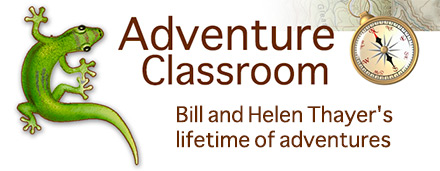


NATURALLY AWESOME
This section presents short stories about some of the places and creatures we've seen on our adventures...POLAR BEARS
The polar bear is a carnivorous bear whose native range lies largely within the Arctic Circle, encompassing the Arctic Ocean, its surrounding seas and surrounding land masses. The polar bear has an extremely well developed sense of smell, being able to detect seals nearly 1.6 km (1 mi) away and buried under 1 m (3 ft) of snow. Its hearing is about as acute as that of a human, and its vision is also good at long distances. The polar bear is an excellent swimmer and often will swim for days. Mature bears tend to eat only the calorie-rich skin and blubber of the seal, which are highly digestible, whereas younger bears consume the protein-rich red meat.
[SEE MORE]
GOBI DESERT BEARS
The Gobi bear is a subspecies of the brown bear, Ursus arctos. It is listed as critically endangered; the population includes less than 40 adults. Gobi bears mainly eat roots, berries, and other plants, sometimes rodents. Small compared to other brown bear subspecies, adult males weigh about 100 kilograms (250 lbs) Although the Gobi bears were never plentiful, their decline truly started in the 1960s when the Mongolian government, then dominated by the Soviet Union, encouraged an increase in livestock production in and around the desert. This policy took a toll on the already sparse vegetation and sparked killing of bears, which were likely seen as a threat to the domesticated animals, even though the bears never eat other large animals.
[SEE MORE]
GOBI DESERT CAMELS
The domesticated Bactrian camel has served as a pack animal in inner Asia since ancient times. Bactrian camels are exceptionally adept at withstanding wide variations in temperature – ranging from freezing cold to blistering heat. They have a remarkable ability to go without water for months at a time, but when water is available they may drink up to 57 liters at once. When well fed, the humps are plump and erect, but as resources decline, the humps shrink and lean to the side. When moving faster than a walking speed, they pace, by stepping forwards with both legs on the same side (as opposed to trotting, using alternate diagonals as done by most other quadrupeds). Speeds of up to 65 kilometres per hour (40 mph) have been recorded, but they rarely move this fast. Bactrian camels are also said to be good swimmers, although in the desert they don't get much practice.
[SEE MORE]
BAKING BREAD IN SAND
The Sahara Nomads use an exceptionally low-tech and fuel-efficient baking method. They can actually produce a delicious and healthy flat bread by cooking the bread dough in hot sand. After the bread bakes it is a welcomed addition to the desert dinner fare, spread in the tent.
[SEE MORE]
DESERTS SCORPIONS
Scorpions are members of the class Arachnida and are closely related to spiders, mites, and ticks. They are commonly thought of as desert dwellers, but they also live in Brazilian forests, British Columbia, North Carolina, and even the Himalayas. They have been around for hundreds of millions of years, and they are nothing if not survivors. There are almost 2,000 scorpion species, of which 30 or 40 have strong enough poison to kill a person.
[SEE MORE]
